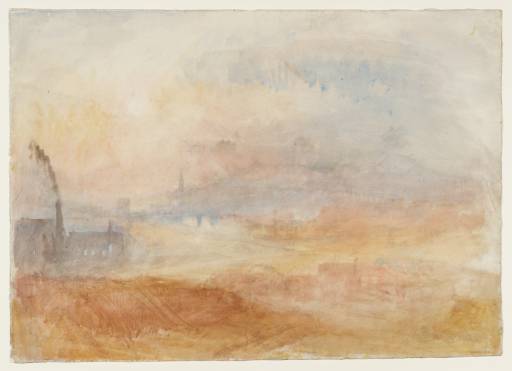Joseph Mallord William Turner An Industrial Town at Sunset, Probably Birmingham or Dudley c.1830-2
Joseph Mallord William Turner,
An Industrial Town at Sunset, Probably Birmingham or Dudley
c.1830-2
Joseph Mallord William Turner 1775–1851
An Industrial Town at Sunset, Probably Birmingham or Dudley c.1830–2
D25250
Turner Bequest CCLXIII 128
Turner Bequest CCLXIII 128
Watercolour on white wove paper, 348 x 482 mm
Blind-stamped with Turner Bequest monogram towards bottom centre
Stamped in black ‘CCLXIII – 128’ bottom right
Blind-stamped with Turner Bequest monogram towards bottom centre
Stamped in black ‘CCLXIII – 128’ bottom right
Accepted by the nation as part of the Turner Bequest 1856
Exhibition history
1964
Loan of Turner Watercolours from the British Museum, Graves Art Gallery, Sheffield, December 1964–January 1965, University of Nottingham Art Gallery, January–March 1965 (no catalogue, as ‘Dudley, Worcs’).
1980
Turner and the Sublime, Art Gallery of Ontario, Toronto, November 1980–January 1981, Yale Center for British Art, New Haven, February–April 1981, British Museum, London, May–September 1981 (85, reproduced in colour, as ‘Study of an Industrial Town at Sunset’, c.1830).
1992
Turner: The Fifth Decade: Watercolours 1830–1840, Tate Gallery, London, February–May 1992 (17, reproduced in colour, as ‘Colour Study: An Industrial Town at Sunset, ?Dudley’, c.1830–2).
1993
The Art of Seeing: John Ruskin and the Victorian Eye, Phoenix Art Museum, March–May 1993, Indianapolis Museum of Art, June–August 1993 (no number, reproduced, as ‘Study of an Industrial Town at Sunset’, c.1830).
2005
Turner’s Picture of Britain, Clore Gallery, Tate Britain, London, June 2005–April 2006 (no catalogue).
2007
British Vision: Observation and Imagination in British Art 1750–1950, Museum voor Schone Kunsten, Ghent, October 2007–January 2008 (11, reproduced in colour, as ‘An Industrial Town, probably Birmingham, at Sunset; Colour Study’, c.1830–2).
2012
Turner Inspired: In the Light of Claude, National Gallery, London, March–June 2012 (no number, reproduced in colour, as ‘An Industrial Town, probably Birmingham, at Sunset; Colour Study’. c.1830–2).
References
1909
A.J. Finberg, A Complete Inventory of the Drawings of the Turner Bequest, London 1909, vol.II, p.824, CCLXIII 128, as ‘Dudley, Worc. (?)’. c.1820–30.
1980
Andrew Wilton, Turner and the Sublime, exhibition catalogue, Art Gallery of Ontario, Toronto 1980, p.168 no.85, as ‘Study of an Industrial Town at Sunset’. c.1830, pl.17 (colour).
1992
Anne Lyles, Turner: The Fifth Decade: Watercolours 1830–1840, exhibition catalogue, Tate Gallery, London 1992, pp.16, reproduced in colour p.27, 54 no.17, reproduced, as ‘Colour Study: An Industrial Town at Sunset, ?Dudley’. c.1830–2.
1997
William S. Rodner, J.M.W. Turner: Romantic Painter of the Industrial Revolution, Berkeley and London 1997, figure 55, as ‘Study of an Industrial Town at Sunset’. c.1830.
1997
Eric Shanes, Turner’s Watercolour Explorations 1810–1842, exhibition catalogue, Tate Gallery, London 1997, pp.96, 98, 105 (p.96 Appendix I under ‘England and Wales Series’, as ‘Sketch for a view of Birmingham?’. ?c.1830, p.98 under ‘Industrial Scenery’, as ‘Birmingham?’. ?c.1830, p.105 Appendix II, as ‘Sketch: Birmingham?’).
2004
Turner at Tate Britain, London [2004], p.14, reproduced in colour.
2007
Ian Warrell in Robert Hoozee, John Gage, Timothy Hyman and others, British Vision: Observation and Imagination in British Art 1750–1950, exhibition catalogue, Museum voor Schone Kunsten, Ghent 2007, p.80 no.11, reproduced in colour, as ‘An Industrial Town, probably Birmingham, at Sunset; Colour Study’. c.1830–2.
Andrew Wilton has compared the subject and atmosphere of this colour study with the finished watercolour Dudley, Worcestershire of about 1832 (Lady Lever Art Gallery, Port Sunlight),1 engraved in 1835 for the Picturesque Views in England and Wales (Tate impressions: T05097, T06113, T06114), both having ‘obscurity and smoke hazily illuminated by the fires of industry’, with natural ‘light diffused through an artificial fog of haze and smoke’.2 Anne Lyles has called the present work ‘a remarkably radiant image’, projecting ‘an optimistic view of industrial activity’,3 following Wilton’s description of it as ‘a poem of almost lyrical enchantment with the new conditions in which the world assumed such grand forms’, contradicting John Ruskin’s reading of Turner’s works as evidence of (as Wilton puts it) ‘the tragedy of the industrial revolution’.4
The silhouetted buildings on the left are comparable with those on the left of Dudley, Worcestershire, but the overall landscape has a feeling of greater space and distance. In his survey linking Turner’s ‘colour beginnings’ to finished watercolours, Eric Shanes has suggested Birmingham as the subject.5 Comparable pencil sketches made in the Kenilworth sketchbook on Turner’s 1830 tour of the Midlands include Tate D21999, D22003 and D22023 (Turner Bequest CCXXXVIII 14a, 16a, 26a).6 A colour study linked by Shanes to Dudley, Worcestershire is Tate D25350 (Turner Bequest CCLXIII 228).
See also the introductions to the present subsection of identified subjects and the overall England and Wales ‘colour beginnings’ grouping to which this work has been assigned.
Technical notes:
There is a fold down the centre of the sheet, which is more evident from the verso. The upper edge shows evidence of folding and freehand tearing, the sheet probably having originally formed half of a larger one. The watercolour ends at the fold, presumably indicating that Turner worked with the other half tucked away.
There is a fold down the centre of the sheet, which is more evident from the verso. The upper edge shows evidence of folding and freehand tearing, the sheet probably having originally formed half of a larger one. The watercolour ends at the fold, presumably indicating that Turner worked with the other half tucked away.
Verso:
Blank, save for inscriptions at the bottom left: in pencil ‘AB 93 P’; stamped in black with Turner Bequest monogram above ‘CCLXIII – 128’; and in pencil ‘CCLXIII 128’.
Blank, save for inscriptions at the bottom left: in pencil ‘AB 93 P’; stamped in black with Turner Bequest monogram above ‘CCLXIII – 128’; and in pencil ‘CCLXIII 128’.
Matthew Imms
March 2013
How to cite
Matthew Imms, ‘An Industrial Town at Sunset, Probably Birmingham or Dudley c.1830–2 by Joseph Mallord William Turner’, catalogue entry, March 2013, in David Blayney Brown (ed.), J.M.W. Turner: Sketchbooks, Drawings and Watercolours, Tate Research Publication, December 2013, https://www

